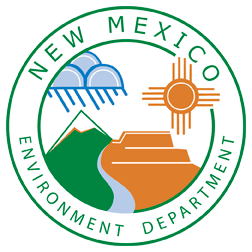CONTENTS
Background Information Supporting Development of The Rule
Links to Other Agencies’ Clandestine Drug Laboratory Information
Cleanup Guidance
Contamination from the operation of clandestine drug laboratories (CDLs) is a serious health and environmental threat. Remediation (or cleanup) of the residually contaminated portions of CDL properties is essential to assure the health, safety and welfare of the people of New Mexico and their environment. This section provides guidance for the cleanup of seized laboratories, as well as guidance on reporting that cleanup to the New Mexico Environment Department.
EPA Voluntary Guidelines for Methamphetamine Laboratory Cleanup
Checklist for Evaluating a Cleanup Contractor
Analytical laboratories that generate environmental data for government agencies for regulatory purposes must be certified.
Remediation company staff will need to determine remediation requirements at a specific site, based on chemicals found, processes used and how long the lab was active. In rare cases, proper remediation may require demolition of a contaminated structure. In a few cases (e.g., an uninhabitable shed), a determination of “no further action required” may be made after venting, and removal of chemicals, apparatus and wastes left at the site. Most situations will require a middle course involving one or more of the following measures:
- Removal: Furnishings, draperies, carpeting, paneling, wallpaper, etc., that evaluators believe cannot be cleaned using other methods must be disposed of according to the type and degree of contamination. Some materials may not be suitable for landfill disposal but must be disposed of by a licensed contractor.
- Ventilation: When solvents and other chemicals that may have soaked into the walls are slowly vaporizing indoors, ventilation may reduce contamination and decrease odors.
- Neutralization: Where acids or bases have been used, the potential for harmful effects may be reduced or removed through neutralization. Acids may be neutralized with solutions of sodium bicarbonate (baking soda), and bases may be neutralized by using weakly acidic solutions of vinegar or acetic acid in water.
- Detergent-Water Washing: Some nonporous and semi-porous surfaces, such as floors, tiles, walls and ceilings, can be scrubbed with detergent and water solutions. Depending on the situation, some porous materials, such as carpeting and draperies, may also be decontaminated through washing. Steam cleaning or high-pressure washes may be helpful for large areas of contamination.
- Encapsulation or Sealing: Contamination may be covered with layers of oil-based paint, polyurethane, or other materials.
Outdoor contamination may be dealt with using one or more of: (1) waste removal, (2) drainage control, (3) removal or treatment of contaminated soils or water, (4) provision for alternate water supplies when water sources are contaminated, or (5) site controls such as fencing or signs.
Public Outreach
NMED does not certify remediation contractors. The remediation firm shall be under the direction of a certified industrial hygienist or be approved and currently registered to perform such work with a state, county, or municipal agency during the time the firm participates in the assessment or remediation of residual contamination. A firm’s approval, certification, or registration with another state to perform assessments of residually contaminated properties will be accepted as meeting this requirement.
Presentation: New Mexico’s CDL Cleanup Rule and Process
List of Remediation Contractors
Note: NMED recommends that the remediation firm performing the preliminary and post-remediation assessments be a different firm than the one that performs the remediation, to ensure independent evaluation of work required and thoroughness of the remediation.
List of Chemicals Associated with CDL Residual Contamination
Background Information Supporting Development of The Rule
Background Information Supporting Development of The Rule
Following are National Jewish Medical and Research Center Clandestine Methamphetamine Laboratory Research Papers that were used as reference material in the development of New Mexico’s Clandestine Drug Lab Remediation Rule.
September 2005
Chemical Exposures Associated with Clandestine Methamphetamine Laboratories Using the Hypophosphorous and Phosphorous Flake Method of Production
John W. Martyny, Michael Van Dyke, Charles S. McCammon, Nicola Erb, Shawn Arbuckle
August 2005
A 24-Hour Study to Investigate Chemical Exposures Associated with Clandestine Methamphetamine Laboratories
John W. Martyny, Nicola Erb, Shawn L. Arbuckle, Michael V. VanDyke
July 2004
Methamphetamine Contamination on Environmental Surfaces Caused by Simulated Smoking of Methamphetamine
John W. Martyny, Shawn L. Arbuckle, Charles S. McCammon, Nicola Erb
March 2004
Chemical Exposures Associated with Clandestine Methamphetamine Laboratories Using the Anhydrous Ammonia Method of Production
John W. Martyny, Shawn L. Arbuckle, Charles S. McCammon, Nicola Erb
January 2004
Chemical Exposures Associated with Clandestine Methamphetamine Laboratories
John W. Martyny, Shawn L. Arbuckle, Charles S. McCammon, Eric J. Esswein, Nicola Erb
List of Chemicals Associated with CDL Residual Contamination
Articles & Fact Sheets
Chemical Hazards Related to Clandestine Drug Laboratories (PDF: 32KB; 6 pages)
Hughart. Agency for Toxic Substances and Disease Registry (ATSDR). 2000. Good information on Meth, Ecstasy, Rohypnol and GHB; manufacturing process; chemicals used; wastes produced; and hazards to children.
Heavy Metal and Organic Contaminants Associated With Illicit Meth Production (PDF: 1343KB; 8 pages)
Brent T. Burton. 1991 Burton discusses injury and illness caused by accidents of the meth cooking process, including those caused by processing errors, chemical interactions, etc.
Illegal Methamphetamine Labs: Information for Health Care Providers (PDF: 37KB; 1 page)
Minnesota Department of Health. This list of chemicals and chemical types, and the health risks associated with them can be distributed to health care providers caring for children taken from labs; to law enforcement or other agency staff concerned about exposure to lab chemicals; or to other concerned people.
Medical Surveillance Program (PDF: 15KB; 2 pages)
Occupational Health Services, U.C. Davis. This program is included as an example of a medical surveillance program for clan lab responders (including law enforcement officers, HazMat teams, etc.) whose repeated exposure to hazardous chemicals may put them at risk for health effects from those toxic exposures.
Methamphetamines: an epidemic of clandestine labs and health risk (PDF: 121KB; 22 pages)
(presentation) Michelle R. Chesley, MD. Howard University Hospital Dept. of Emergency Medicine, Sep 1999. This presentation Includes historical perspective; meth health effects and effects in users; manufacturing process, and extensive information on chemicals used.
Methamphetamine Labs: Community Risks and Public Health Responses (PDF: 27KB; 4 pages)
Jeffery Burgess. Washington Public Health. Fall 1997. The article discusses chemical toxicity; health effects; treatment for those exposed at labs – including law enforcement staff; and public policy.
Overview of Medical Toxicology and Potential for Exposures to Clandestine Drug Laboratories in California (PDF: 24KB; 4 pages)
Thomas Ferguson, MD. 2000. Ferguson focuses on health effects in children from lab environments.
Links to Other Agencies’ Clandestine Drug Laboratory Information
Links to Other Agencies’ Clandestine Drug Laboratory Information
The links below contain information about CDL cleanup (primarily of meth labs) from various state agencies.
Colorado Department of Public Health and Environment
Oklahoma Department of Environmental Quality
Oregon Department of Health and Human Services

